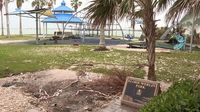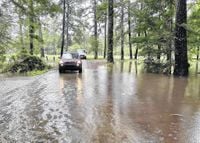SARASOTA, Fla. - The aftermath of Hurricanes Helene and Milton has left a significant mark on the City of Sarasota, with damage reported across every park and recreation facility. While some locations have reopened, many others require extensive repairs and will take time to recover. As the city begins the rebuilding process, officials are emphasizing the need to strengthen these beloved community spaces.
The backstory reveals the extent of the destruction: concrete slabs were dislodged by the powerful waves, parts of the Tony Saprito Pier were washed away, and the docks at Hart's Landing were left in ruins. Jerry Fogel, the City of Sarasota's Parks and Recreation director, described the scene, stating, "The one thing that I saw with all of our parks is almost like a grenade went off." Every park he visited required repairs, particularly those situated near the water, which fared the worst.
Fogel elaborated on the devastation, saying, "The fishing piers were devastated. Boat ramps were destroyed. Playgrounds were destroyed. Pavilions were damaged. I could go on and on." The city has estimated the total damage at approximately $17.4 million.
In response, crews from the City of Sarasota have been working diligently to address the damage. Nikesh Patel, Sarasota's city engineer, reported that 16 projects are currently in the design phase, with significant repairs needed at Eloise Werlin Park, Tony Saprito Fishing Pier, and Ken Thompson Park, each requiring over $1 million for restoration.
Patel explained the complexities involved in the rebuilding process, stating, "To maximize the FEMA funding, we have to go through the public procurement process, and we anticipate having that completed by early 2026, with construction starting shortly after that and completion expected in late 2026 to early 2027." He noted that supply chain issues are also contributing to delays, as many municipalities across Florida are facing similar challenges following the hurricanes.
As businesses in the area begin to reopen, the City of Sarasota is focused on not just rebuilding but enhancing the resilience of its parks and recreation facilities. Mayor Liz Alpert emphasized this point, saying, "I think resiliency is going to be the key word going forward for the city, and we are looking at ways to make things more resilient." Fogel echoed this sentiment, stating, "We aren’t just going to build back like the same that it is now. We are going to build back better, stronger, with better materials and things of that nature. So if we do get, Lord forbid, hit with anything, hopefully not, we will be better prepared for that."
Meanwhile, as Florida continues to grapple with the effects of climate change and extreme weather, the National Tropical Weather Conference in Texas has issued a forecast predicting an above-average Atlantic hurricane season for 2025. According to a report published by Colorado State University, the upcoming season is expected to see 17 named storms, including 9 hurricanes and 4 major hurricanes, which is significantly higher than the historical averages.
Phil Klotzbach, a research scientist at Colorado State University, explained that the warmer temperatures in the Atlantic Ocean contribute to the increased likelihood of storm formation. He stated, "A warmer Atlantic basically just provides more energy, more fuel for storms." The report also indicated that there is a 51% probability of major hurricanes making landfall along the U.S. coastline in 2025, compared to the historical average of 43%.
Robeson County, still recovering from the impacts of Hurricane Matthew in 2016 and Tropical Storm Debby in 2024, is particularly concerned about the 2025 forecast. The county has experienced significant flooding and damage from past storms, and the upcoming hurricane season poses a renewed threat.
As the hurricane season approaches, residents are reminded that it only takes one storm to create a significant impact. The Atlantic hurricane season officially runs from June 1 to November 30, with the peak season occurring from mid-August to late October. During this time, hurricanes can bring heavy rains, flooding, and even tornadoes, making thorough preparations essential for coastal communities.
In addition to the local impacts of the hurricanes, the World Meteorological Organization has announced the retirement of the names Helene, Milton, and Beryl due to the severity of the storms in 2024. The names Brianna, Holly, and Miguel will replace them in the official list of Atlantic storm names. Helene was particularly devastating, causing 249 fatalities and $78.7 billion in damages, making it one of the deadliest and most expensive storms in U.S. history.
Milton followed closely behind, causing $34.3 billion in damage primarily in Florida, while Beryl, which formed as the earliest Category 5 storm in a season, resulted in 68 deaths across multiple countries, including the United States and Grenada.
As the community of Sarasota and others along the coast prepare for the upcoming hurricane season, the focus remains on resilience and recovery. The lessons learned from past storms will shape the rebuilding efforts, ensuring that cities are better equipped to handle future challenges posed by increasingly severe weather.





